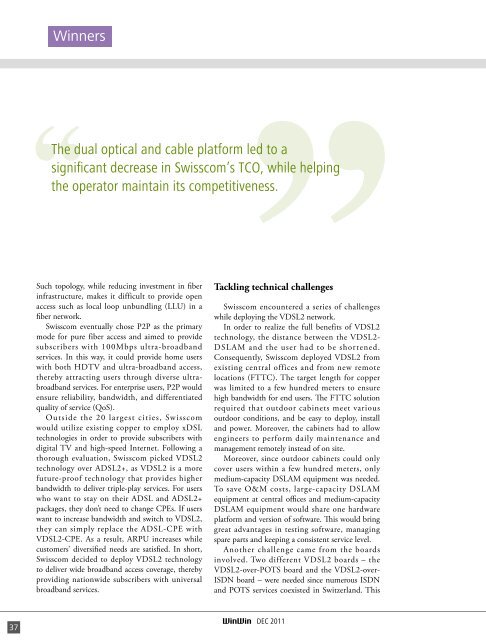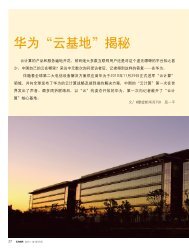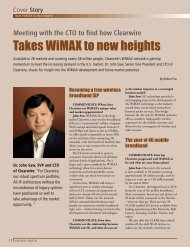Telekom Malaysia - Huawei
Telekom Malaysia - Huawei
Telekom Malaysia - Huawei
You also want an ePaper? Increase the reach of your titles
YUMPU automatically turns print PDFs into web optimized ePapers that Google loves.
Winners<br />
The dual optical and cable platform led to a<br />
significant decrease in Swisscom’s TCO, while helping<br />
the operator maintain its competitiveness.<br />
Such topology, while reducing investment in fiber<br />
infrastructure, makes it difficult to provide open<br />
access such as local loop unbundling (LLU) in a<br />
fiber network.<br />
Swisscom eventually chose P2P as the primary<br />
mode for pure fiber access and aimed to provide<br />
subscribers with 100Mbps ultra-broadband<br />
services. In this way, it could provide home users<br />
with both HDTV and ultra-broadband access,<br />
thereby attracting users through diverse ultrabroadband<br />
services. For enterprise users, P2P would<br />
ensure reliability, bandwidth, and differentiated<br />
quality of service (QoS).<br />
Outside the 20 largest cities, Swisscom<br />
would utilize existing copper to employ xDSL<br />
technologies in order to provide subscribers with<br />
digital TV and high-speed Internet. Following a<br />
thorough evaluation, Swisscom picked VDSL2<br />
technology over ADSL2+, as VDSL2 is a more<br />
future-proof technology that provides higher<br />
bandwidth to deliver triple-play services. For users<br />
who want to stay on their ADSL and ADSL2+<br />
packages, they don’t need to change CPEs. If users<br />
want to increase bandwidth and switch to VDSL2,<br />
they can simply replace the ADSL-CPE with<br />
VDSL2-CPE. As a result, ARPU increases while<br />
customers’ diversified needs are satisfied. In short,<br />
Swisscom decided to deploy VDSL2 technology<br />
to deliver wide broadband access coverage, thereby<br />
providing nationwide subscribers with universal<br />
broadband services.<br />
Tackling technical challenges<br />
Swisscom encountered a series of challenges<br />
while deploying the VDSL2 network.<br />
In order to realize the full benefits of VDSL2<br />
technology, the distance between the VDSL2-<br />
DSLAM and the user had to be shortened.<br />
Consequently, Swisscom deployed VDSL2 from<br />
existing central offices and from new remote<br />
locations (FTTC). The target length for copper<br />
was limited to a few hundred meters to ensure<br />
high bandwidth for end users. The FTTC solution<br />
required that outdoor cabinets meet various<br />
outdoor conditions, and be easy to deploy, install<br />
and power. Moreover, the cabinets had to allow<br />
engineers to perform daily maintenance and<br />
management remotely instead of on site.<br />
Moreover, since outdoor cabinets could only<br />
cover users within a few hundred meters, only<br />
medium-capacity DSLAM equipment was needed.<br />
To save O&M costs, large-capacity DSLAM<br />
equipment at central offices and medium-capacity<br />
DSLAM equipment would share one hardware<br />
platform and version of software. This would bring<br />
great advantages in testing software, managing<br />
spare parts and keeping a consistent service level.<br />
Another challenge came from the boards<br />
involved. Two different VDSL2 boards – the<br />
VDSL2-over-POTS board and the VDSL2-over-<br />
ISDN board – were needed since numerous ISDN<br />
and POTS services coexisted in Switzerland. This<br />
37<br />
DEC 2011

















